Aral Sea, Uzbekistan
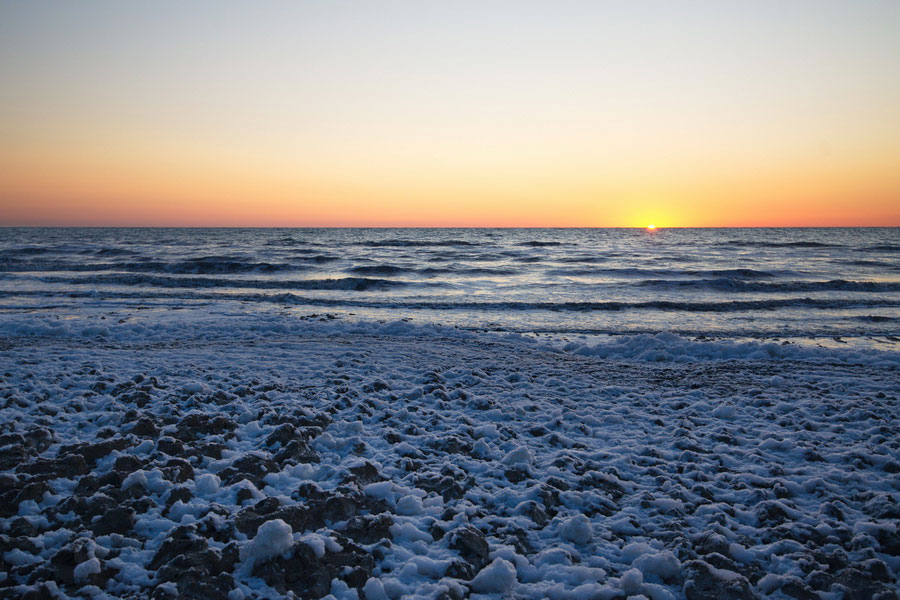
Dawn on the Aral Sea
The Aral Sea was once the fourth largest lake in the world but has shrunk to a tenth of its size over the past fifty years. Today, it stands as a stark example of a major ecological disaster. In 1960, the lake spanned an area of 68,900 square kilometers, but by 2020, it had reduced to less than 7,000 square kilometers. The water level has fallen by 25 meters, and the salinity has increased to such an extent that it has exterminated all fish species, resembling the conditions of the Dead Sea.
The lake is fed by the Amu Darya and Syr Darya rivers. However, due to extensive water usage for irrigation and changes in climate, it now receives only a fraction of the water it needs – about 20 times less. The former port cities of Muynak and Aralsk are now located dozens of kilometers from the shoreline, their docks transformed into ghostly ship graveyards. The dried-up lakebed has turned into a vast desert known as the Aralkum, similar to the Kyzylkum and Karakum deserts.
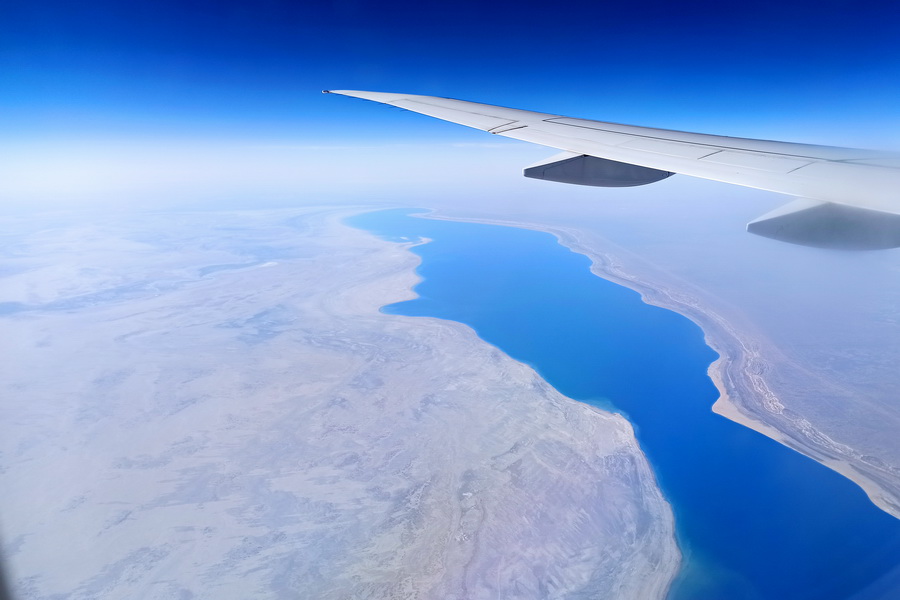 The Aral Sea from an airplane, to the left of the water is the Aralkum desert
The Aral Sea from an airplane, to the left of the water is the Aralkum desert
Our travel guide offers intriguing facts about the Aral Sea and details what to expect when touring this remarkable region.
Aral Sea Tours
Tours to the Aral Sea usually start from Nukus, which is about 200 km away from the former port town of Muynak. From Muynak, it's an additional 100 km of off-road travel to reach the current shoreline of the sea. Nukus has an international airport with daily flights from Tashkent and weekly flights from Moscow and other cities in the CIS. You can also find SUVs with knowledgeable drivers in Nukus, ready to navigate the routes around the Aral Sea.
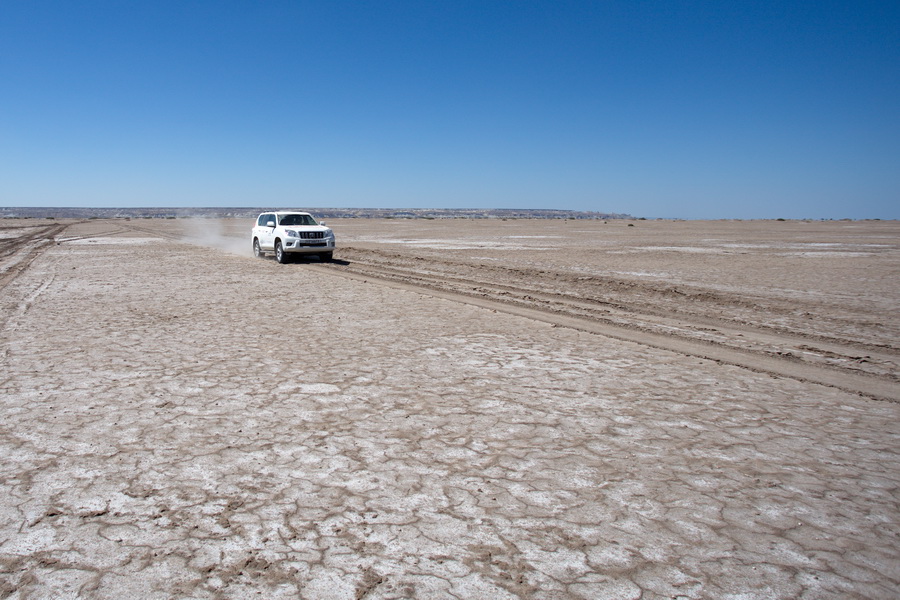 Road along the former bottom of the Aral Sea
Road along the former bottom of the Aral Sea
A typical Aral Sea tour spans two days. On the first day, tourists depart from Nukus and drive on a paved road to Muynak where they visit the local museum and the ship graveyard. From there, they continue on a dirt road to the shores of the Aral Sea. The journey includes climbing up to the Ustyurt Plateau and then descending to a yurt camp. On the second day, visitors can walk along the sea shore, swim if they wish, and then return via Sudochie Lake, passing through the abandoned fishing village of Urga.
It is possible to visit the Aral Sea in a single day, but this would significantly limit the time for sightseeing and would require leaving Nukus before dawn. Alternatively, the trip can be extended to explore north along the coastline towards Kazakhstan, or include a visit to the Barsa-Kelmes salt marsh on the return journey.
History of the Aral Sea
The geological history of the Aral Sea is relatively short – it formed just 17,600 years ago from the melting glaciers in the Pamir and Tian Shan mountains at the end of the last ice age. Studies show that the sea's water level has varied throughout its history. For instance, in 2001, researchers discovered a 12th-century mausoleum, Kerderi, on the former seabed in the Kazakh part of the sea. This site had been submerged during the 15th and 16th centuries and remained under 20 meters of water until the late 20th century.
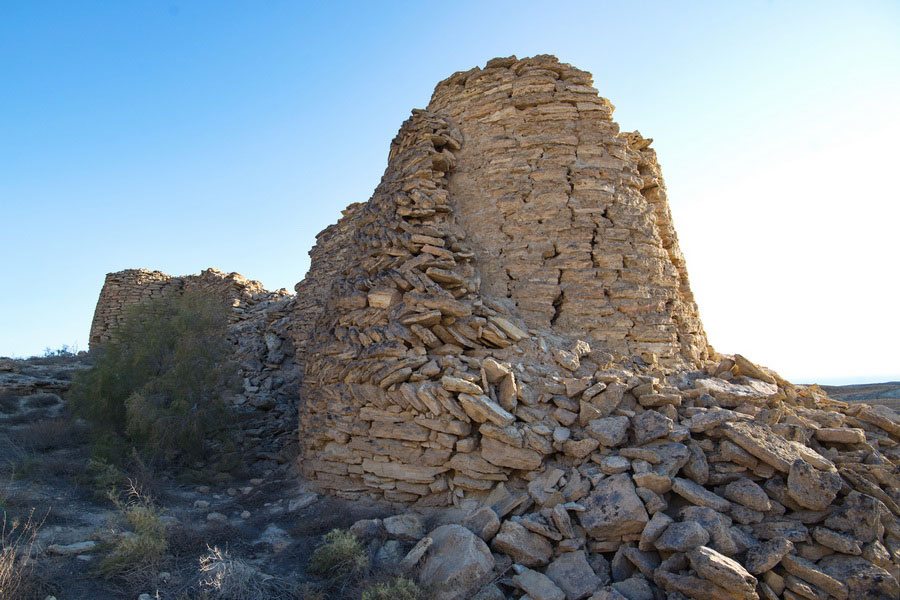 Kurgancha-Kala fortress
Kurgancha-Kala fortress
The first known ships on the Aral Sea appeared in the mid-19th century. By the early 20th century, the sea was bustling with fishing fleets that, in their best years, harvested over 50,000 tons of fish annually.
The ecological disaster at the Aral Sea began in 1960 when a sharp decline in the water level was first noticed. Over the next 30 years, the lake halved in size, and by 30 years later, only 10% of its original area remained.
Dive deeper into history of the Aral Sea.
Aral Sea Attractions
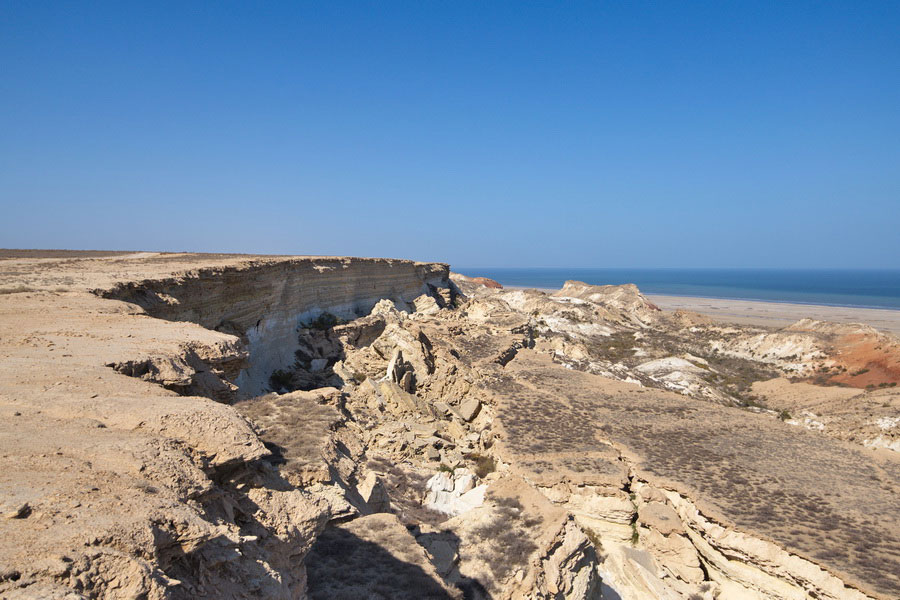 Cliffs of the Ustyurt plateau over the Aral Sea
Cliffs of the Ustyurt plateau over the Aral Sea
The main attraction of the Aral Sea is its modern coastline, or more accurately, the journey to it. This route offers a stark view of the ecological disaster’s extent and shows just how far the waters have receded.
The ship graveyard in Muynak is a poignant sight, where a small group of ships from the 1980s slowly rust away, turning into iron skeletons. Today, 11 ships and boats stand there.
Kurgancha-Kala, built in the 13th century, served as a refuge and outpost for caravans. It’s located 100 km northwest of Muynak on the Ustyurt Plateau. A yurt camp for tourists now lies nearby.
Sudochie consists of several lakes that were once connected to the Aral Sea. The area was once prolific in its fish production, harvesting 2,000 tons of fish, and the western shore was home to the fishing village of Urga, another reminder of the ecological tragedy.
Aralsk-7, a secret Soviet-era city on Vozrozhdeniya (Renaissance) Island, was used for developing and testing biological weapons. It was abandoned in 1992, and the laboratories were dismantled. Today, the city has been razed, and it is no longer visited.
Aral Sea in Kazakhstan
The northern part of the Aral Sea is situated within Kazakhstan. Aralsk, akin to Muynak in Uzbekistan, hosts a collection of old ships that remain permanently moored at the port. The city has faced challenges due to the receding waters, but the construction of the Kokaral Dam between 2003 and 2005 has helped to conserve water in the sea. This area is now known as the Small Aral, and there are ambitious projects in progress to expand the dam, which could raise the water level enough to reach Aralsk.
 Ships preserved in the museum of the city of Aralsk
Ships preserved in the museum of the city of Aralsk
Attractions in the Kazakh part of the Aral Sea include:
Kerderi – a 12th-century mausoleum influenced by Islamic culture with elements of shamanism and Tengrism, situated on the former seabed, 170 km southwest of Aralsk.
Raim – the remnants of a Russian fort at the point where the Syr Darya flows into the Aral Sea. Today, it stands as ruins and eroded walls, located 100 km south of Aralsk.
Traveling to both the Uzbek and Kazakh parts of the Aral Sea is a daunting and lengthy endeavor. To travel from Muynak to Aralsk, one needs to take a significant detour over 1800 km via the Ustyurt Plateau. Other options include a sequence of flights from Nukus to Tashkent to Almaty to Kyzylorda and then a 450 km drive to Aralsk; or a flight from Nukus to Tashkent followed by almost a day on the Tashkent-Moscow train, which makes a stop in Aralsk.
How to Get to the Aral Sea
An SUV is essential! While the town of Muynak is accessible by paved road in a standard car, reaching the current shores of the Aral Sea requires an all-wheel-drive vehicle with high ground clearance and strong tires. Several companies in Nukus offer such SUVs with drivers.
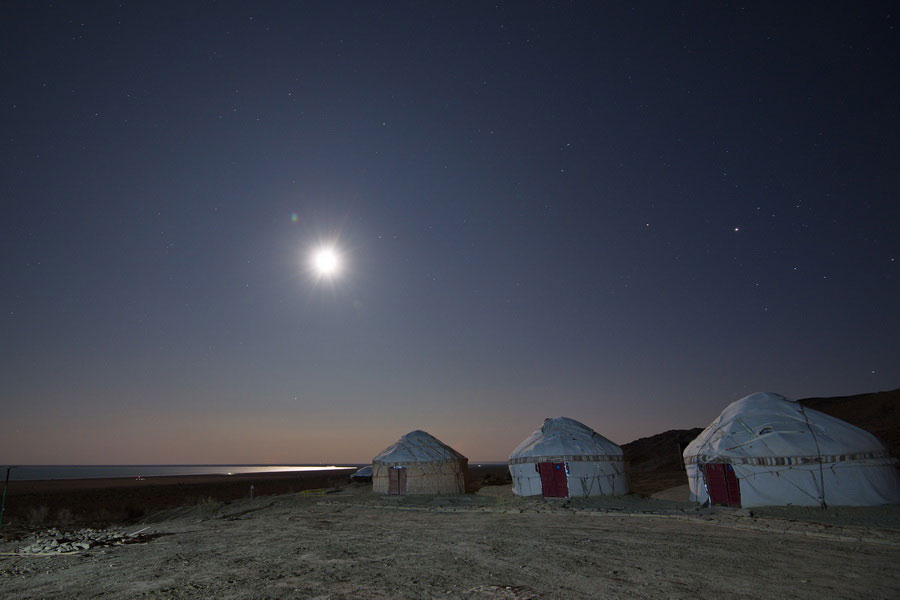 Overnight in a yurt camp on the Aral Sea
Overnight in a yurt camp on the Aral Sea
The journey to the Aral Sea typically begins in Nukus, which is accessible by plane from Tashkent or by car from Khiva. It’s 200 km from Nukus to Muynak, and another 130 km from Muynak to a yurt camp on the Aral Sea shore. For those who wish to extend their experience, there's an option to drive an additional 70 km north along the coast. This part of the trip includes a descent from the Ustyurt Plateau to the coast, offering stunning views of cliffs and rock formations. However, this extension requires an additional day and extra fuel canisters.
Safety at the Aral Sea
Touring the Aral Sea means venturing into semi-wild desert territories, and we advise against doing so without a guide or a driver who knows all the current dirt roads. Navigating the ascents and descents on the Ustyurt Plateau on the way to the sea demands proficient off-road driving skills. There's also a risk of a vehicle’s wheel sinking into holes made by desert animals or getting mired in mud if driven too close to the waterline. Additionally, outdated GPS tracks available online might direct you to eroded, washed-out roads or collapsed descents from the Ustyurt Plateau.
 The travelers got too close to the shore
The travelers got too close to the shore
While on your trip, you'll have opportunities to view panoramic scenes of the sea from the cliffs of the Ustyurt Plateau. However, it’s best to keep a safe distance as the limestone is loose and crumbly, with some areas featuring overhanging ledges.
If you plan to swim in the Aral Sea, here are a few tips:
- Bring extra water to rinse off the salt after swimming to prevent skin irritation.
- It’s best to enter the water barefoot since the shoreline is made of sticky mud that can trap sandals or flip-flops.
- Avoid getting seawater in your eyes; if it happens, rinse them immediately with plenty of clean freshwater.
There have been no sightings of poisonous insects or snakes in the area for a long time. Depending on the season, be prepared for intense sun and dusty winds—bring sunglasses, a hat or cap, and a scarf.
Best Time to Visit the Aral Sea
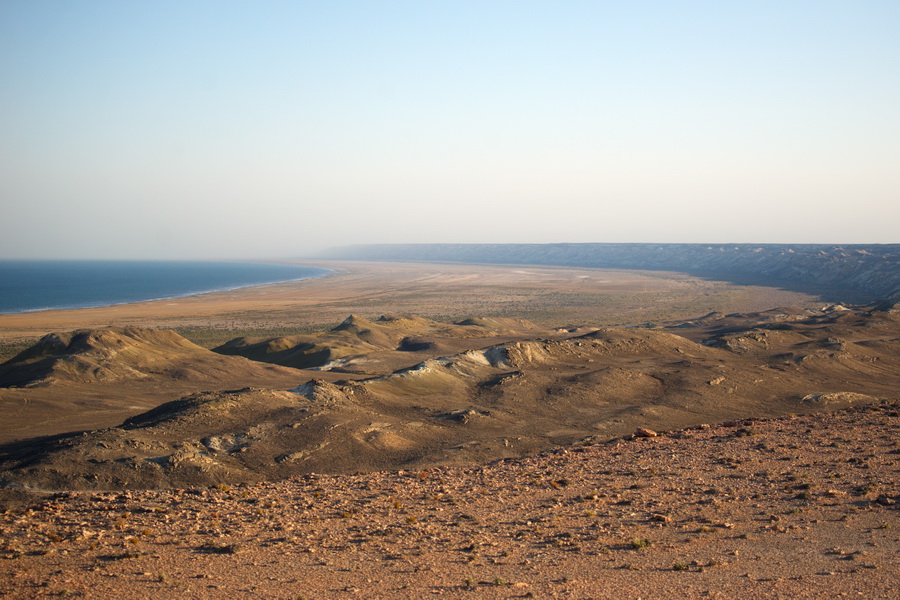 Autumn sunset on the Aral Sea
Autumn sunset on the Aral Sea
The Aral Sea area features a desert-like, dry climate. In the summer, it's extremely hot, with intense sunlight and temperatures often climbing above 40 degrees Celsius (104 degrees Fahrenheit). The winters, meanwhile, are cold and windy. Therefore, the optimal times to visit the Aral Sea are during the spring and fall, which is also the best time for travel across Uzbekistan.


